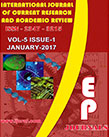Abstract Volume:5 Issue-1 Year-2017 Original Research Articles
 |
Online ISSN : 2347 - 3215 Issues : 12 per year Publisher : Excellent Publishers Email : editorijcret@gmail.com |
COPD is associated with significant extra-pulmonary (systemic) effects among which cardiac complications are most common. COPD affects primarily the right side of heart and cor pulmonale is one of the important causes of increased morbidity and mortality in patients of COPD. Echocardiography provides a rapid, non-invasive method to evaluate the cardiac changes. The aim of the study was to comparatively analyse the 2D FAC and TAPSE as a marker of RV dysfunction in patients of COPD and correlating them with PFT and 6MWT. A total of 100 COPD patients admitted in the P.G. department of Medicine S.N. Medical College, Agra between March 2015 and June 2016 were subjected to thorough clinical evaluation, spirometry, 6MWT and 2D echocardiography and the results were analysed to establish comparison between 2D FAC and TAPSE and their correlation with PFT and 6MWT. In our study the values of both 2D FAC and TAPSE correlated positively with the value of FEV1 (PFT) and 6MWT i.e. lower value of 2D FAC and TAPSE corresponded to lower value of FEV1 (higher GOLD stage) and 6MWT indicating a poorer prognosis in patients of COPD. As per 2D FAC 30% of the patients had normal RV function, 70% had RV dysfunction and as per TAPSE 19% patients had normal RV function, 81% had RV dysfunction. Among patients with RV systolic dysfunction, as per the values of 2D FAC, 29% patients were with mild systolic dysfunction, 26% patients were with moderate RV systolic dysfunction and 15% were with severe RV systolic dysfunction and as per the values of TAPSE , 40% patients were with mild systolic dysfunction, 26% patients were with moderate RV systolic dysfunction and 15% were with severe RV systolic dysfunction showing that TAPSE was a more sensitive indicator of mild RV dysfunction while for diagnosing moderate and severe RV dysfunction both parameters had similar sensitivity. In present study TAPSE picked 11% cases of mild RV dysfunction which were negative by 2D FAC. So TAPSE should be preferred over 2D FAC in assessment of RV function especially in early stages of COPD.
How to cite this article:
Manish Kumar Bansal, Bechan Kumar Gautam. 2017. Comparative Analysis of Assessment of RV Dysfunction using 2D FAC and TAPSE in Patients of COPD and their Correlation with Pulmonary Function Test (PFT) and 6 Minute Walk Test (6MWT).Int.J.Curr.Res.Aca.Rev. 5(1): 54-60doi: http://dx.doi.org/10.20546/ijcrar.2017.501.006



Quick Navigation
- Print Article
- Full Text PDF
- How to Cite this Article
- on Google
- on Google Scholor
- Citation Alert By Google Scholar
